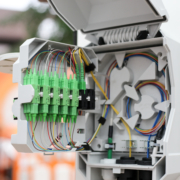PON Telecom Technology
Passive Optical Networks
A Passive Optical Network (PON) is a broadband network access technology that offers a faster and more effective broadband solution. PONs are exciting because they provide a high-bandwidth, point-to-multipoint connection with no active electronics on the customer premises. As a result, this makes PON telecom technology simpler, less expensive, and more reliable than other broadband technologies.
What is PON in Telecommunication?
PON in Telecommunication is fibre optic technology that helps to drive success by using splitters to divide bandwidth. This way, a PON can use multiple wavelengths for data on a single optical fibre. One wavelength can be used for downstream traffic and another for upstream traffic, making it the final step between a single ISP and its many customers. This makes PON an important technology for telecommunication.
Fibre optic technology is essential for PON to function correctly and efficiently. By splitting the bandwidth with the help of fibre optic splitters, a PON can use multiple wavelengths for data on a single optical fibre. This allows one wavelength – on a single fibre – to be used for downstream traffic and another for upstream traffic. This makes PON an important technology for telecommunication. Without the use of fibre optics, PON would not be as successful as it is today.
Benefits of PON
High Speeds
Broadband networks are becoming increasingly important in modern society. Consumers want high speeds and PON can provide these speeds easily. Gbps speeds can be handled by PON and with shared fibre, this speed can even rise to 2 Gbps. This will reduce waiting times for data transfer and provide a seamless internet experience.
Scalability
A single fibre optic network can be split among many different connections, making it easier for businesses to expand their IT capabilities. This scalability is a major advantage of PON technology.
Reliability
Another plus for PON is its reliability. In fact, it’s been tested and proven to be more reliable than both DSL and cable modem technologies. This is in part due to its passive optical nature, there are no electronics that can fail. And since the signal is transmitted over light, it’s less prone to interference than other types of signals.
Choice of Services
The many wavelengths available on a single fibre optic cable allow you to take advantage of more internet services than ever before. One of the main benefits of broadband network access is the internet connection it grants you. but PON brings additional services. Furthermore, phone services and video conferencing software can also use the same line to deliver a comprehensive telecommunication package.
Affordable
A PON is a cost-effective broadband solution that offers many benefits, such as high speeds and reliability. Because a single optical fibre can connect to numerous users, there are fewer material and infrastructure costs involved. As a result, it’s much more affordable than an exclusive fibre connection between yourself and a provider.
What is GPON?
GPON, or Gigabit Passive Optical Network, is a technology for delivering high-speed internet access over optical fibre. GPON makes use of a passive optical network, which consists of optical splitters and optical terminals that allow a single optical fibre to be used to provide service to multiple users. This eliminates the need for separate fibres for each user, which can save money and make installation easier.
GPON delivers Gigabit speeds, making it an ideal technology for delivering high-speed internet access, IPTV, and VoIP services. In addition, it can also be used to create a fibre to the home (FTTH) network, which can provide residents with high-speed internet access, cable TV, and telephone service.
How Does GPON Work?
GPON is a point-to-multipoint network, which means that it uses a single optical fibre to provide service to multiple users. The optical fibre is divided into sections called segments, and each user is assigned a segment. The optical signal from the central office is split into multiple signals, and each signal is sent down a different segment. At the end of each segment, an optical terminal converts the optical signal back into an electrical signal, which is then delivered to the user’s premises.
What Are the Benefits of GPON?
- GPON can save money by eliminating the need for separate fibres for each user.
- Ease of installation: GPON is easy to install, which can save time and money.
- Gigabit speeds: GPON delivers Gigabit speeds, making it an ideal technology for delivering high-speed internet access, IPTV, and VoIP services.
- Fibre to the home: GPON can be used to create a fibre to the home (FTTH) network, which can provide residents with high-speed internet access, cable TV, and telephone service.





